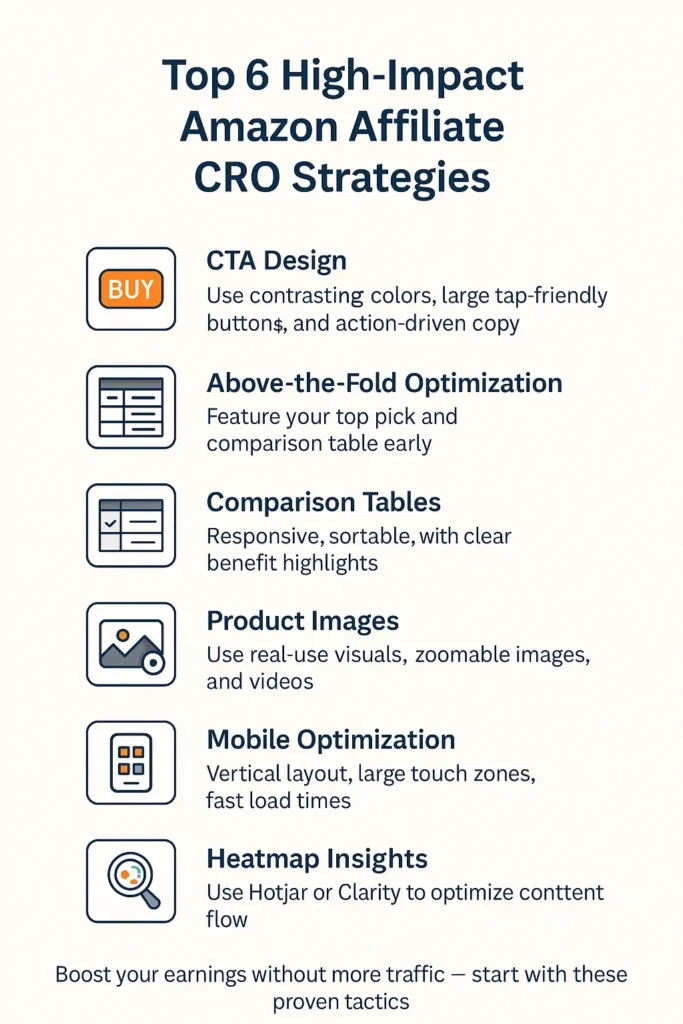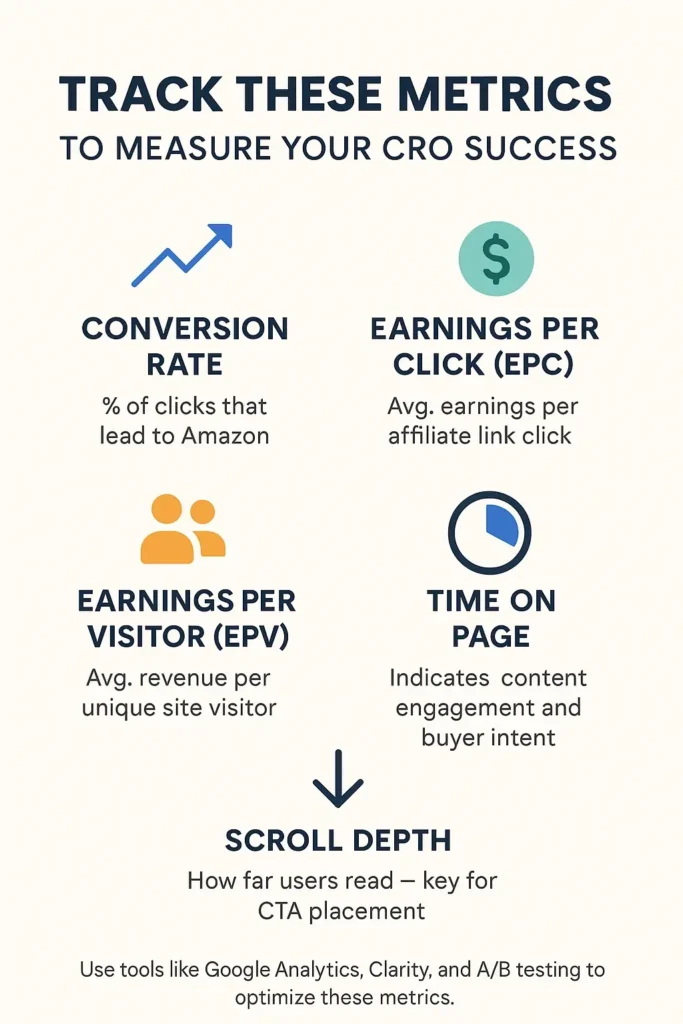15 Proven Amazon Affiliate CRO Strategies That Increase Earnings (Without More Traffic)

Introduction: Turn Your Existing Traffic into Revenue
Are you struggling to convert your blog visitors into Amazon affiliate sales? You’re not alone. Many content creators focus only on increasing traffic — but Amazon affiliate CRO strategies can unlock much higher earnings from your existing audience. This guide shows you how to optimize what you already have for better results.The truth is, strategic conversion rate optimization (CRO) can often double your affiliate revenue without a single additional visitor.
In this comprehensive guide, we’ll explore practical CRO techniques specifically designed for Amazon Associates. Whether you’re a seasoned affiliate marketer or just getting started, these strategies will help you transform your current traffic into sustainable income.
Why CRO Matters More Than Ever for Amazon Affiliates
With Amazon’s commission rates becoming increasingly competitive, maximizing every visitor’s potential value is essential. If you’re still building your foundation, check out our complete guide on how to start a blog and make money in 2025 — it’s the perfect companion for any affiliate CRO plan. Consider this: increasing your conversion rate from 2% to 4% doubles your income without any additional marketing costs. This efficiency makes CRO one of the highest-ROI activities for affiliate marketers today. That’s why understanding and applying effective Amazon affiliate CRO strategies can dramatically improve your results.
According to a recent study by Income School, the average Amazon affiliate conversion rate hovers around 3.5%, but top performers consistently achieve 7-10% with strategic optimization techniques. Let’s explore how you can join those top performers.
15 High-Impact Amazon Affiliate CRO Strategies That Work in 2025
Not sure where to start? Here’s a visual summary of the top Amazon affiliate CRO strategies to focus on:

1. Amazon Affiliate CTA Optimization: Design and Placement Strategies
Your call-to-action buttons are conversion gateways. Their design, placement, and messaging dramatically influence click-through rates:
- Color Psychology: Use contrasting colors that stand out from your site’s color scheme. Orange and red CTAs typically outperform neutral tones in testing.
- Button Size: Ensure buttons are large enough to be easily tapped on mobile (minimum 44×44 pixels).
- Compelling Copy: Replace generic “Buy Now” text with benefit-focused alternatives like “Check Latest Price” or “See Reviews on Amazon.”
- Strategic Placement: Position primary CTAs above the fold, after persuasive content blocks, and at natural decision points throughout your content.
Real-World Example: Technology review site TechGearLab improved their conversion rate by 34% by simply changing their CTA from “See it on Amazon” to “Check Current Price” and using a contrasting orange button instead of blue.
We’ve also analyzed how to increase email open rates by 37% with smart tools, and many of the same CTA principles apply.
2. Above-the-Fold Optimization for Amazon Affiliate CRO
The content that appears before scrolling (above the fold) receives significantly more attention:
- Featured Comparison Table: Place a comparison table of top recommendations immediately after your introduction.
- Best Pick Highlight: Showcase your top recommendation with image, key benefits, and CTA above the fold.
- Clear Value Proposition: Explicitly state why readers should trust your recommendations early in the content.
Implementation Tip: Your above-the-fold content should answer three questions within seconds: What products are being recommended? Why should I trust these recommendations? How can I quickly find what I need?
3. Optimizing Comparison Tables for Higher Amazon Affiliate Conversions
Comparison tables are conversion powerhouses when properly implemented:
| Product | Key Benefit | Price Range | Rating | Check Price |
|---|---|---|---|---|
| Product A | Best Overall Performance | $$$$ | ⭐⭐⭐⭐⭐ | Check Price |
| Product B | Best Budget Option | $$ | ⭐⭐⭐⭐ | Check Price |
| Product C | Most Durable | $$$ | ⭐⭐⭐⭐½ | Check Price |
- Mobile Optimization: Ensure tables are responsive and horizontal scrolling is smooth on mobile devices.
- Visual Hierarchy: Use color-coding or badges to highlight key differentiators (e.g., “Best Value” or “Editor’s Choice”).
- Sortable Features: Allow users to sort by price, rating, or features when possible.
4. Visual CRO Tactics: Images that Boost Amazon Affiliate Conversions
Visual content significantly impacts conversion rates:
- High-Quality Images: Use large, zoomable product images from multiple angles.
- Visual Comparison: Create side-by-side visual comparisons highlighting key differences.
- Contextual Usage Images: Show products being used in real-life situations.
- Video Integration: Embed product videos and demonstrations where appropriate.
Conversion Insight: According to A/B testing data from Wirecutter, product images showing the item in use convert 23% better than standard product images alone.
5. CRO-Driven Content Structure for Amazon Affiliates
Restructure your content to highlight benefits over features:
- Problem-Solution Format: Begin sections by identifying reader problems, then position products as solutions.
- Benefit-Driven Headers: Craft H2 and H3 headers around benefits rather than generic descriptions.
- AIDA Framework: Structure content using the Attention, Interest, Desire, Action formula for persuasive flow.
- If you’re writing affiliate blog posts, learn how to write content that ranks #1 on Google — it complements CRO by driving qualified traffic that’s ready to convert.
These Amazon affiliate CRO strategies are based on proven persuasion models that top affiliates already use.
6. A/B Testing for Amazon Affiliate CRO Success
Systematic testing reveals what actually works for your specific audience:
- Testing Tools: Use Google Optimize (free) or VWO for affiliate sites
- Key Elements to Test:
- CTA button color, size, and copy
- Product image size and placement
- Heading structures and benefit statements
- Comparison table formats
- Content organization (e.g., pros/cons first vs. features first)
Testing Framework: Start with high-impact elements (CTAs, comparison tables) before testing minor changes. Run tests for at least 1-2 weeks to gather statistically significant data.
7. Using Social Proof to Improve Amazon Affiliate CRO
Combining CRO with list-building? Check out ConvertKit vs Mailchimp and see which email platform converts better.
Social validation dramatically increases conversion probability:
- Review Aggregation: Include aggregate review scores from Amazon with star ratings.
- Purchase Volume Indicators: Mention how many units have been sold when impressive.
- Authority Endorsements: Reference expert opinions or professional recommendations.
- Social Sharing Data: Display social share counts to demonstrate popularity.
8. Optimize Mobile User Experience
With over 65% of affiliate traffic now coming from mobile devices, mobile optimization is essential:
- Touch Target Sizing: Ensure all clickable elements are at least 44×44 pixels.
- Vertical Scrolling: Reorganize comparison tables for vertical rather than horizontal scrolling on mobile.
- Simplified Navigation: Implement jump links to help users navigate long content.
- Loading Speed: Optimize image sizes and implement lazy loading for faster performance.
Real-World Results: Outdoor Gear Lab increased mobile conversions by 41% by implementing a mobile-first redesign focusing on touch-friendly navigation and vertical scrolling comparison tables.
Want to take it further? Learn how Core Web Vitals impact your CRO and SEO in our technical optimization guide.
9. Heatmap Analysis for Amazon Affiliate Conversion Optimization
Heatmap tools reveal exactly how users interact with your content:
- Recommended Tools: Hotjar, Crazy Egg, or Microsoft Clarity (free)
- Key Insights to Find:
- How far users scroll down the page
- Where users click most frequently
- Areas receiving focused attention
- Where users abandon the page
Analysis Approach: Look for “dead zones” where important content is being ignored and “hot zones” that could be optimized with stronger CTAs.
10. Optimize Content Readability
Easy-to-consume content improves engagement and conversion:
- Scannable Structure: Use bullet points, numbered lists, and clear subheadings.
- Short Paragraphs: Limit paragraphs to 3-4 sentences maximum.
- Visual Breaks: Use images, quotes, or callout boxes to break up text.
- Readable Fonts: Use minimum 16px font size and high-contrast colors.
11. Copywriting Techniques to Improve Amazon Affiliate CRO
Strategic word choice significantly impacts conversion rates:
- Urgency Triggers: Incorporate limited-time offers or inventory notifications when truthful.
- Scarcity Signals: Mention when products are frequently out of stock if accurate.
- Pain Point Emphasis: Clearly articulate the problems each product solves.
- Objection Handling: Address common concerns proactively within your content.
12. Implement Progressive Disclosure
Don’t overwhelm visitors with information all at once:
- Product Cards: Use expandable content areas that reveal detailed specifications on click.
- Tab Navigation: Organize content into tabs (Features, Specs, Alternatives, etc.).
- Read More Links: Hide secondary information behind “Read More” toggles.
13. Create Strategic Exit-Intent Offers
Capture leaving visitors with timely offers:
- Related Product Recommendations: Show alternative products when users appear to be leaving.
- Content Upgrades: Offer downloadable buying guides or checklists.
- Newsletter Signup: Provide value by offering to notify visitors of price drops.
- Want to monetize email more effectively? Explore the ultimate guide to monetizing your email list.
14. Optimize Anchor Text and Internal Linking
Strategic internal linking improves user flow and conversion opportunities:
- Benefit-Focused Anchor Text: Use descriptive text that hints at value rather than generic “click here” links.
- Related Product Links: Link to complementary products for cross-selling opportunities.
- Buying Guide Integration: Link to detailed buying guides from product reviews and vice versa.
15. Smart Filtering Strategies for Better Amazon Affiliate Conversions
Help visitors find the perfect product more efficiently:
- Price Range Filters: Let users filter by budget categories.
- Feature-Based Sorting: Allow sorting by the most important specifications.
- Persona-Based Recommendations: Group recommendations by user type (e.g., “Best for Beginners”).
If you’re still choosing your niche, our Amazon affiliate niche strategy guide will help you pick a winner that converts.
Measuring Success: Key CRO Metrics for Amazon Affiliates
Tracking the right metrics ensures your optimization efforts are effective:
Below is a quick visual reference of the five most important CRO metrics every Amazon affiliate should monitor:

- Conversion Rate: The percentage of visitors who click through to Amazon.
- Earnings Per Click (EPC): Average revenue generated per affiliate link click.
- Earnings Per Visitor (EPV): Average revenue generated per site visitor.
- Time on Page: Higher engagement often correlates with conversion intent.
- Scroll Depth: Determines how much of your content is actually being consumed.
Case Study: How One Affiliate Site Doubled Conversions in 30 Days
Home appliance review site KitchenGearPro implemented a systematic CRO strategy with impressive results:
Their approach included several Amazon affiliate CRO strategies that led to a major increase in conversions.
- Initial Situation: 2.1% conversion rate, $0.17 earnings per visitor
- CRO Actions Implemented:
- Redesigned comparison tables for improved mobile experience
- Moved product cards above the fold
- Implemented benefit-focused CTAs
- Added video demonstrations for top products
- Created expandable FAQ sections
- Results After 30 Days:
- Conversion rate increased to 4.7% (+124%)
- Earnings per visitor increased to $0.41 (+141%)
- Average time on page increased by 37%
The most impactful change was implementing mobile-optimized comparison tables, which alone accounted for a 47% conversion increase.
Expert Insights: What Industry Leaders Say About Affiliate CRO
Spencer Haws, founder of Niche Pursuits, emphasizes: “The difference between average and exceptional affiliate sites isn’t just content quality—it’s strategic CRO. The best performers I see are constantly testing and optimizing their highest-traffic pages.”
Doug Cunnington of Niche Site Project adds: “Many affiliates obsess over keyword research but neglect conversion optimization. In today’s competitive landscape, effective CRO is what separates profitable sites from those that struggle to monetize their traffic.”
Gael Breton of Authority Hacker notes: “We’ve found that a well-designed, mobile-first comparison table placed above the fold consistently outperforms all other CRO tactics for Amazon affiliates. It’s the single highest-ROI change most sites can implement.”
Implementing Your CRO Strategy: A Step-by-Step Approach
- Audit Current Performance: Identify your baseline conversion rates and earnings per visitor.
- Prioritize High-Impact Pages: Focus on your highest-traffic pages first.
- Implement Heatmap Analysis: Understand how users currently interact with your content.
- Develop Testing Hypotheses: Create specific predictions about which changes will improve conversions.
- Run Systematic A/B Tests: Test one significant change at a time.
- Document Results: Maintain a record of what works and what doesn’t for your specific audience.
- Scale Successful Changes: Apply proven optimizations across your site.
- Continuous Iteration: Establish a regular schedule for ongoing CRO work.
Frequently Asked Questions
How long should I run A/B tests for accurate results?
For most affiliate sites, tests should run for a minimum of 7-14 days to account for weekly traffic fluctuations. Ensure you reach statistical significance (usually 95% confidence) before declaring a winner. Lower-traffic sites may need to run tests for 30+ days to gather sufficient data.
Which CRO tools offer the best value for Amazon affiliates?
For beginners, Microsoft Clarity (free heatmaps) and Google Optimize (free A/B testing) provide excellent value. As you scale, consider Hotjar for advanced user behavior analysis and VWO or Optimizely for comprehensive testing capabilities The investment in premium tools typically pays for itself through improved conversion rates.
How do I prioritize which pages to optimize first?
Follow the 80/20 rule: identify the 20% of pages that drive 80% of your affiliate revenue. Within those pages, prioritize based on:
- Traffic volume
- Current conversion rate (looking for underperformers)
- Commercial intent (product reviews typically have higher conversion potential than informational content)
Should I focus on mobile or desktop optimization first?
Check your analytics to determine your traffic split. Most affiliate sites now see 60-70% mobile traffic, making mobile optimization the priority. However, if your particular niche skews heavily toward desktop users (e.g., B2B products), prioritize accordingly.
How do I balance SEO content requirements with conversion optimization?
The best affiliate content satisfies both search engines and users. Structure content with comprehensive information for SEO while using strategic formatting (comparison tables, bullet points, clear CTAs) to facilitate conversions. Remember that improved user engagement signals (time on page, low bounce rate) benefit both SEO and conversions.
Learn how to structure content that ranks in our complete SEO writing guide.
Conclusion: The Competitive Edge of Continuous Optimization
In today’s competitive affiliate landscape, traffic alone isn’t enough—conversion optimization is the multiplier that transforms visitors into revenue. By implementing the strategies outlined in this guide, you can significantly increase your Amazon affiliate earnings without the need for additional traffic.
Remember that CRO is not a one-time task but an ongoing process of testing, learning, and refinement. The most successful affiliate marketers maintain a regular schedule of conversion optimization work, constantly looking for new ways to improve the user experience and facilitate purchasing decisions. By consistently applying these Amazon affiliate CRO strategies, you’ll turn more readers into revenue without extra traffic.
Ready to take your affiliate marketing to the next level? And if you’re just starting out, don’t miss our beginner’s guide to the best affiliate programs in 2025 — perfect to pair with CRO for higher commissions. Join our Telegram channel “BloggingRevenue” for weekly CRO tips, case studies, and the latest affiliate marketing strategies.








